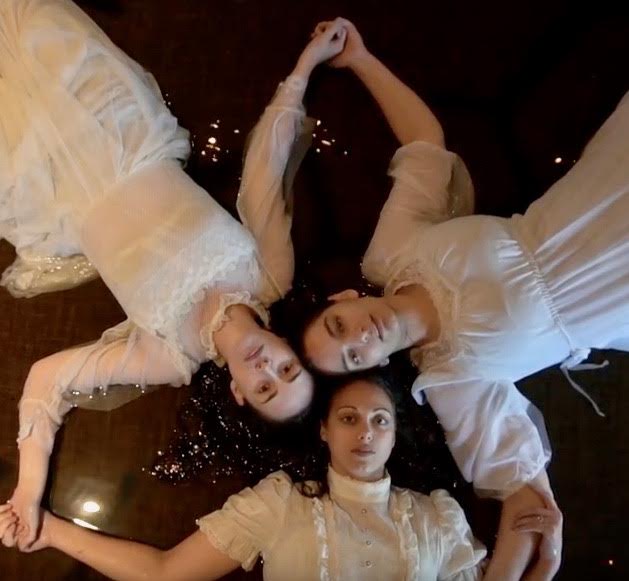
Ethereal and evocative ‘The Drowning Girls’ is a captivating tale of seduction, abuse and murder
By
Fourth Wall Down introduces itself to St. Louis with “The Drowning Girls,” a haunting story of multiple murders by drowning as recalled by the victims. Set in the Edwardian period, the disturbing but true story has a moody, gothic feel that envelops the audience from the moment they walk into the theater space. Surrounded by an art installation and the constant sound of water in motion, the play tackles the very ugly acts of domestic abuse and murder in a story that moves as if in graceful reverie.
The gruesome story begins as two of the three women suddenly come to consciousness again. Gasping for air and looking around in confusion as they emerge from the water, they are soon joined by the third victim, more recently murdered and a bit more disoriented. As the three women tell how they were seduced then murdered, their performances and horrific stories are equally unsettling and captivating. If these women are muses to a dream, it is a nightmare that compels you not to wake too soon.
The first victim is Beatrice, or Bessie, played by Kilby Elisabeth Yarbrough with a sense of somber maturity, as if she has had the time to understand her situation. Yarbrough gives Bessie a nurturing, careful demeanor with a quick and easy laugh that’s warm and compassionate. Her courtship was fairly traditional, a single girl in her late twenties she eagerly fell for the handsome and articulate man who pursued her hand in marriage. They were married for some time before she met her untimely end.
The second victim is Alice, played with vibrant urgency and a hunger for life by Léerin Campbell. Alice is the youngest of the brides; she’s stubborn, willful and full of curiosity. A girl from a comfortable family, her parents were shocked at the speed with which she and her husband met, courted and became engaged. Just six weeks after her wedding, she too was discovered drowned in her bathtub. The murder devastated her family but also led them to notice that she had died in the same manner as several other women.
The final victim, Margaret, played with sincerity, shyness and timidity by Sabra Sellers, is the oldest of the three. In her late thirties, she had resolved herself to the life of an old maid, for Edwardian women had few rights and even fewer options, before being swept off her feet. She was quickly married and even more quickly dispatched to a watery grave the very next night.
Throughout the show, the three women respond to sound cues and the infrequent commands of the shows director and provocateur Nick Henderson. He rhythmically bangs his cane on the floor and the women’s demeanor changes, their conversations momentarily turning to murmurs. He slowly walks around the stage and the women’s eyes follow him intently, when he whistles, they dance a halting waltz in the water. As the story unfolds, the women are emboldened, their voices gaining force and unity, the intentions resolved. What were once fragments -- disjointed and uncertain memories -- becomes a clear picture and the cause of their death becomes the focus of their vengeance.
Presented in the round, with a set design by Henderson, the audience cannot help but see the reactions of other theatergoers, which heightens the tension in the room. The set is a pool containing three claw foot tubs on wheels encircled by chandeliers made from miscellaneous piping and jute. Several of the tub walls have been mended with jute string where the steel and porcelain has rusted out. The actors are continually moving, changing, rearranging until they get it just right. The movement is hypnotic and fluid, then abruptly altered when one of the actors slips her head beneath the water before emerging to continue her story or burst out laughing with an uncertain shake in her voice.
With intertwined narratives and choreography that gives the show a ballet-like quality, “The Drowning Girls” uses memory and repetition to slowly reveal the secret behind the women’s deaths, and the effect is enthralling. Eerily similar in execution, each woman tells how she was isolated, controlled and manipulated by her husband before falling prey to murderous hands. The details are unpleasant at times, even the women’s personification of their husbands can be intimidating and, always, just beyond the stage, we see and hear a lone man in a chair, seemingly influencing the women still. The effect works, quite well, but the show may be a trigger moment for those who have experienced relationship violence or other forms of abuse.
Not all theater patrons will appreciate the puzzle box style of the play running through July 14. The story is parsed out in small details and presented in nonlinear fashion. The similarities in each woman’s demise are clearly apparent, but the connection and meaning of this is not immediately evident. Nonetheless, “The Drowning Girls,” by Beth Graham, Daniela Waskalic and Charlie Tomlinson and produced by Fourth Wall Down, a theatre collective, is beautifully evocative theater with a message that resonates even as it thoroughly entertains.


